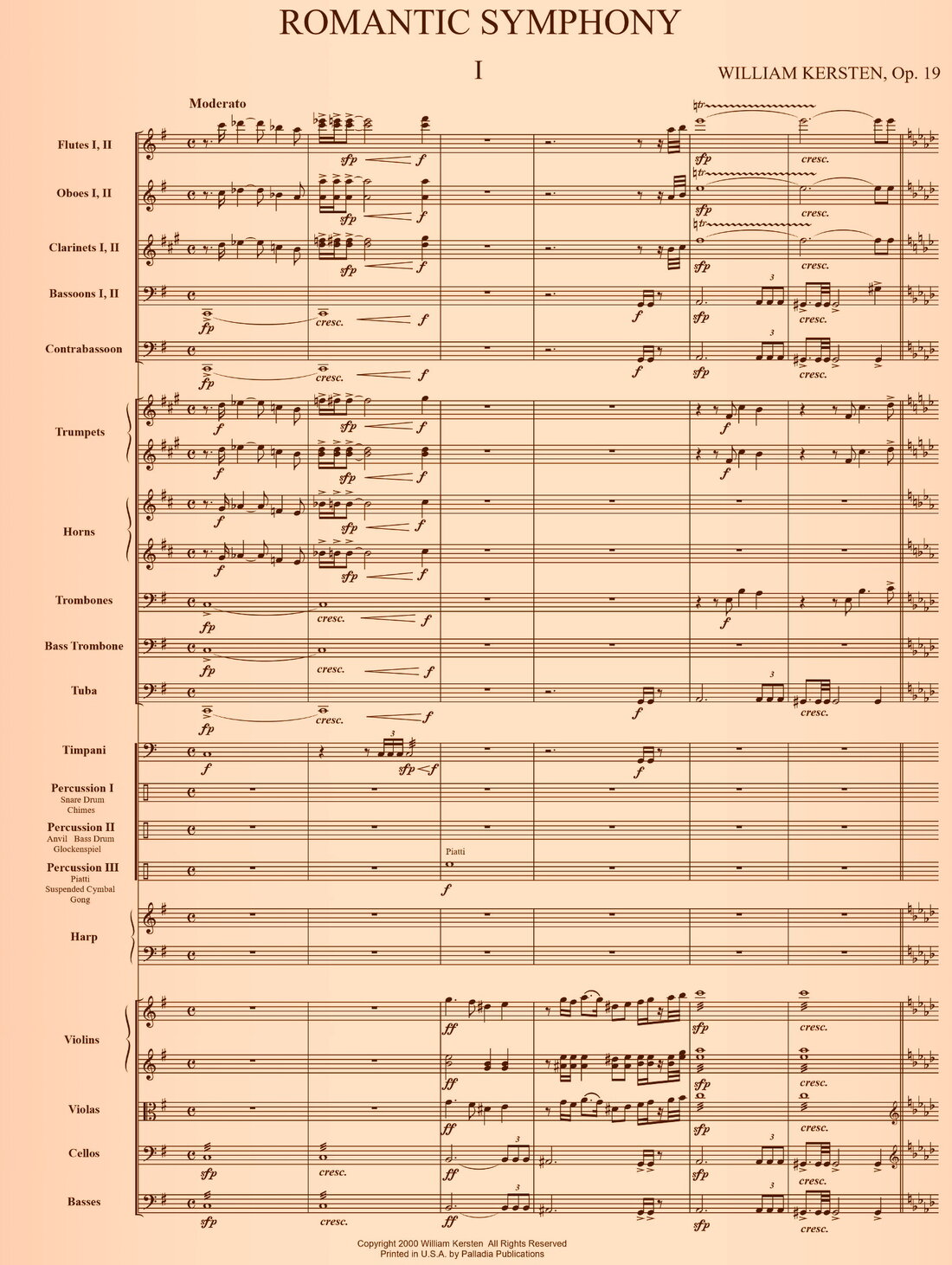
WILLIAM KERSTEN
Symphony No. 1 "Romantic," Op. 19 (1996)
I Moderato
II Adagio Dolore
III Scherzo
IV Finale
INSTRUMENTATION
2 Flutes
2 Oboes
2 Clarinets
2 Bassoons
Contrabassoon
3 Trumpets
4 Horns
2 Trombones
Bass Trombone
Tuba
Timpani
Percussion
Pipe Organ
Harp
Violins I
Violins II
Violas
Cellos
Basses
"In the Romantic Symphony (Symphony No. 1 Op. 17) Kersten has provided no obvious program. Still it moves where the spirit moves him as though following the action of a drama, not where strict attention to musical form once demanded, but to where heart's desires and instincts demand. Kersten knows what many of his contemporary composers don't evidently know, or at least don't care to express: that contemporary music can reflect its time and still be accessible to listeners who want to be thrilled by modern sounds adorned with lovely melodies, without being pummelled by extraordinarily gritty dissonance. The symphony has power and drama. It also has rapture and radiance. Bright-hued with touches of foreboding throughout, every theme singing smoothly, every development integrated and effortless, the work defies neat classificiation other than to say that at its most profound (the first movement) it's theatrical and exciting, at its most lyric (the second movment) it's poignant and richly textured, at its most exotic (the third movment) it's exhilirating and enticing, and at its most noble (the fourth movement) it's powerful and spirited and engulfs the listener with a unabashed adrenalin rush as it forges ahead to its triumphant conclusion. From its misty Mahlerian beginnings to its final burst of Wagnerian splendor, Kersten's Romantic Symphony captures a restless urge that propels this expressive and richly varied work in an inspired and engaging way.
- Jack Neal, 2003
"Cries of righteous despair replete with filmic imagery bring about a highly portentous, resolute theme containing fragments of narrative commitment, which is in turn interrupted by penetrating, inescapable anguish that the composer must brave and tame in order to dive into the first movement - and the symphony - proper, where we have a chance to explore the musical and psychological implications of those fierce introductory eruptions. All this happens during the first ninety seconds of the work. The listener embarks upon a personal musical disclosure of events, while receiving the full range and impact of the emotional content of those events, not necessarily in a linear or traditional formal fashion - for which the title of ‘Symphony’ may be misleading unless one’s conceptions and traditional expectations are left behind on this very personal journey. The apparent absence of traditional formal cornerstones doesn’t weaken the larger structure, as the skeletal interweaving of themes and an abundance of dramaturgy and personal dictum, shift the educated audience’s conventional expectations of balance in a large work to the composer’s discretionary points of structural centres, as motivic/harmonic growth, orchestration, style, and even long-range musical targets, all defer to the composer’s own hierarchical system in this work, and serve his narrative and psychological struggles - perhaps ‘Symphonie Fantastique’ or ‘Sinfonia Narrativa’ could be alternative titles. In fact, the narrative intent is so much stronger than the rich musical material, that the movements could easily be perceived as sections of an instead monolithic musical epic, seen through the eyes and expressed in the singular voice of an individual witness. We never become privy to the composer’s story without the intentionally undisclosed literal programme, and that draws us deeper into the work in search of that fascinating story - the very emphatic musical material suggests strong feelings of loss, despair, love, battle, religion, and triumph. Technically, the composer feels secure in his uninhibited use of some Herrmannian, Tchaikovskyan, and Beethovenian devices, and a degree of stylistic eclecticism from different periods, as his own strong and original voice is ubiquitous and assimilating. As one becomes more familiar with this and other works of W. Kersten, one is incrementally allowed greater insight into his mysterious and expansive world - a natural outcome over repeated hearings (a surprisingly welcome venture in the contemporary music world). And it is these repeated hearings that tell us that the work is worthwhile, when we discover something new about it every time; new layers, new elements, or new connections between those elements, etc. W. Kersten’s music is as generous in these respects, as it is inspired. Most of all, it is honest; an almost extinct quality these days, especially in music composition."
- Errikos Vaios, Greece, 2013
Copyright 2000 William C. Kersten